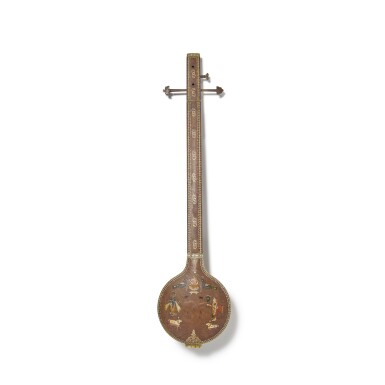
A painted ivory and bone-inlaid wooden musical instrument (tambura), India, Gwalior or Deccan, 19th century
Estimate
4,000 - 6,000 GBP
Lot Details
Description
jackfruit wood, exterior of drum painted in gouache depicting Krishna dancing with Radha and the gopis (rasamandala), the underside painted with a seated figure of Ganesh flanked by peacocks, a fluting Krishna, Radha, and two holy cows below, long handle with floral motifs, set with ivory and bone designs throughout
93cm.
Ex-collection Richard Burnett, eminent collector of musical instruments.
The underside of the tambura has a depiction of the elephant-headed Hindu deity Ganesha, the god of auspicious beginnings. Musicians and dancers in India often begin their performances with a prayer dedicated to Ganesha. The exterior depicts the rasa mandala, with Krishna dancing the rasa lila (the dance of divine love) with Radha in the centre, as well as dancing with every gopi surrounding the couple by multiplying himself several times.
A similar tambura, was sold in Christie’s London, The Oliver Hoare Collection, 25 October 2019, lot 4. An example with similar decoration, attributed to the nineteenth century and probably made in Gwalior, is in the Victoria & Albert Museum, London (acc. no.IM.238-1922; R. Skelton et al., The Indian Heritage: Court life and Arts under Mughal rule, London, 1982, cat. no.565, p.165). Three further comparable tambura instruments, variously attributed to Central and South India, are in the Metropolitan Museum of Art, New York (acc. nos.89.4.189; 46.34.64; 1994.498).
You May Also Like










